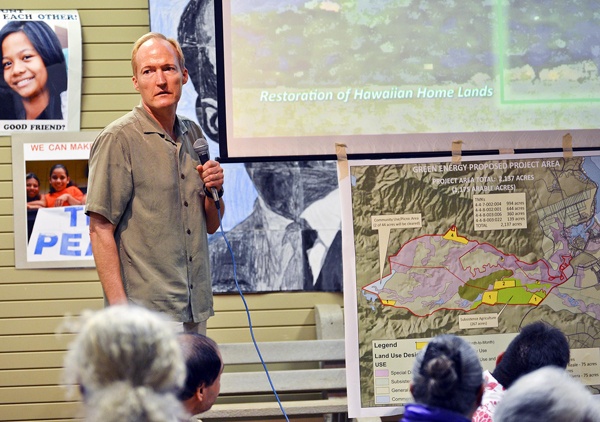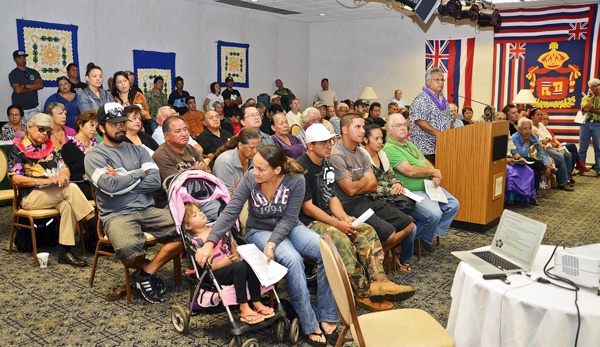HANAMA‘ULU — One week after a fiery and uncontrolled beneficiary consultation meeting in Anahola, the Department of Hawaiian Home Lands held a pair of public hearings to receive testimony on the proposed Anahola Renewable Energy Project. “Let me be clear
HANAMA‘ULU — One week after a fiery and uncontrolled beneficiary consultation meeting in Anahola, the Department of Hawaiian Home Lands held a pair of public hearings to receive testimony on the proposed Anahola Renewable Energy Project.
“Let me be clear that the decision regarding this project has not been made,” Jobie Masagatani, chair-designate of the DHHL, said to begin the Thursday hearing.
Despite receiving additional information Thursday, community members stood firm against the proposal, claiming they have been kept in the dark and that the Hawaiian homestead lands should not be leased to non-Hawaiians.
“(There are) so many issues around the state, but today it’s Anahola,” said Keone Ahlu, of Anahola.
Comments and emotional testimony were provided by dozens of residents, mostly from Anahola, during a pair of public hearings Thursday at King Kaumuali‘i Elementary School and Friday at Aston Aloha Beach Hotel. Both meetings lasted approximately four hours.
The DHHL is proposing to lease 2,137 acres of Anahola lands to Green Energy Team, LLC of Kaua‘i for the purpose of clearing existing albizia trees for its biomass-to-energy facility near Koloa.
The 20-year proposed lease — with an option to extend for 10 more — is for land belonging to native Hawaiians under the Hawaiian Homes Commission Act of 1920. If approved, the land would be used for clearing trees and replanting and harvesting biomass feedstock, which would be delivered to Green Energy’s $90 million facility near Knudsen Gap.
Among the crowd of approximately 200 Thursday were Dan Ahuna, trustee of the Office of Hawaiian Affairs, and Mayor Bernard Carvalho. Both took time to address the community following the meeting.
Carvalho described the hearing as “very emotional” and said he could feel the tension.
“I understand the hearts and souls that are here tonight,” he said. “It’s difficult. I think we’ve got to look at it more from a global type thinking, too. Is it beneficial for this community or not? Is a green type project like this, anywhere on the island, good or not?”
While he believes the DHHL and Green Energy have good intentions, Carvalho agreed there has been misinformation surrounding the proposal.
“I can hear the hearts and souls and feel the energy in this room of just uncertainty and questions,” he said. “But I think the intent and the overall picture is a good thing.”
Ahuna said it was important for the community to voice their concerns.
“It’s your land, it’s about you,” he said. “I just want to congratulate all you guys for coming out here and fighting for what you believe in.”
The proposal
Despite local distrust, Erik Knutzen, co-founder of Green Energy, said his main objective is to clear the land to help meet Kaua‘i’s renewable energy needs and establish homesteading agricultural lots for Hawaiians.
“We recognize this, (that) these are Hawaiian lands,” he said Thursday. “Restoration of these Hawaiian home lands is what this is all about.”
In September 2010, the DHHL received the initial proposal letter from Green Energy. The Homestead Community Development Corporation and Anahola Hawaiian Homes Association submitted a proposal for the same acreage to the DHHL in April 2012, naming Green Energy as its development partner. Then in August 2012, the Hawaiian Homes Commission authorized the DHHL to negotiate the lease with Green Energy, requiring it work with HCDC.
Representatives of neither HCDC nor AHHA were present Thursday to answer community concerns, which angered audience members.
“If they were here tonight to represent themselves, then we would ask them personal questions,” said Kimo Rosa, of Anahola. “Basically they left you guys here to answer questions for them.”
In addition to clearing the invasive albizia — which the DHHL said has left the area unusable — the proposal includes repairing surrounding roads, providing annual lease revenue to the Trust and establishing a Community Benefit Agreement with HCDC and AHHA to maximize value to the impacted community and its beneficiaries.
Knutzen said Green Energy would immediately clear and return 267 acres — 23 percent of the total proposed acreage — to the DHHL for subsistence agriculture. Approximately 850 arable acres would be cleared and replanted with eucalyptus trees to fuel the biomass facility.
“The best lands, which are B and C soil grade … are to be made available now, within the next five years,” Knutzen said. “We want to do this now. It’s been a long time for homesteaders on the (DHHL) list, as you know.”
Emphasizing a point he made last week, Knutzen said Green Energy would simply serve as “the tool” to get Hawaiians back on the land.
“We humbly appreciate that it’s you that matter here,” he said. “It’s not our lands, it’s your lands.”
As part of the project, Green Energy would establish a 2-acre community picnic area near Kaneha Reservoir, allow access to the Department of Land and Natural Resources forest reserve, restore roads and install road drainage.
The Homestead Benefits Agreement with HCDC and AHHA would include a Homestead Participation Revenue of 2 percent of the project’s revenues for beneficiaries, as well as employment training, local hire, internships, fellowships and curriculum development.
Testimony
The main goal of Thursday and Friday’s public hearings was for DHHL commissioners — the five in attendance — to receive testimony on the proposal. Nearly all of it was in opposition.
On Thursday, a variety of concerns were voiced, including water rights, the environmental impacts of burning wood, soil erosion and truck traffic created by shipping trees from Anahola to Koloa. But the main message, voiced by nearly everyone who approached the microphone, urged the DHHL to offer the same 20-year lease to the Hawaiian people, not Green Energy.
“Just say no to this incompetent proposal that continues the genocide of the native Hawaiian,” Bonnie Bator, an Anahola resident, told the commissioners. “Anahola beneficiaries mustn’t bear the load of energy production. The state of Hawai‘i could better achieve its goal of energy independence with solar (and) thermal.”
Chono Fernandes, of Anahola Village, said his ranching family has been displaced by the DHHL several times over the years and that the organization is not taking care of Hawaiians.
“It just seems like you guys don’t have no feelings for people,” he said.
Anne Punohu, of Kapa‘a, said the proposal was presented “piecemeal,” with the Hawaiians getting the short end of the straw.
“I find this project fails on all counts,” she said. “First of all you have not been transparent to the people. You have not conducted your meetings appropriately. You have set two meetings, two acres for a picnic table and two percent (of profits) … Why should the beneficiaries receive 2 percent of the benefit of a corporation that is going to come into Hawaiian home lands and gain 98 percent profit?”
Joe Borden, an Anahola rancher and the newly-elected president of Anahola Farmers and Ranchers Association, presented the commissioners with 707 signatures against the proposal.
“We were not notified until about three or four weeks ago that this was happening for over a couple years,” he said. “We, too, would like to have that same proposal offered to us.”
A young boy, Sean Asquith, approached the microphone and provided testimony speaking only in Hawaiian, drawing applause from the crowd.
One of the most moving speeches came from an emotional Val Ako, an elderly man from Kapa‘a, who spoke about the history of land being taken away.
“We’ve been duped,” he told the commissioners and audience. “Whatever (land) we have left today, give it to us because we are the original owners.”
The next meeting regarding the lease proposal is tentatively scheduled for April 9, at which time the terms and conditions of the lease would be available to the public. Testimony will be allowed.
• Chris D’Angelo, lifestyle writer, can be reached at 245-0441 or lifestyle@thegardenisland.com.



